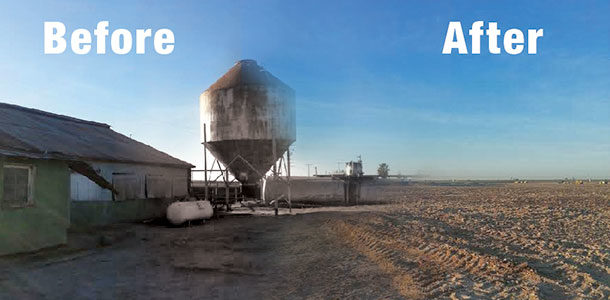When Joey Vasconcellos visits a dairy in California’s San Joaquin Valley, he isn’t there to milk the cows. By the time he arrives, the animals have already been moved. The barns stand empty, the cement floors barren and the metal fabrications quiet without the echo of noise from within. His job – along with his dad, Jerry, and brother Jared – is to deconstruct the facility.
A number of California producers over the past few years, after feeling the pinch of low milk prices, have deemed it more profitable to shutter their dairies and try their hand at growing nut farms, many of them almond, pistachio and walnut orchards. They already have the land; all they need is to turn it into property fit for rows upon rows of trees.
“The nut industry is booming,” Joey said. “A lot of these old, smaller dairies need money and are barely getting by, so they decide to grow nut farms. Some of them with 25 to 50 acres are vacant; they just sit there doing nothing. If the producers can get rid of them, turn the land into something else, they can start to make money again.”
That’s where the Vasconcelloses come in. Their business, Tulare-based JV Recycling and Demolition Inc., which also deconstructs houses, packing yards and other facilities, began with Jerry in the 1970s but slowly died off until a few years ago, when the demand for dairy demolition began to grow.
“We had some big jobs coming up, so we popped back into demolition about three or four years ago,” Joey said, noting in the interim they operated a rock-crushing business that still keeps them busy. “The milk prices dumped so badly for a while that we broke into the dairy industry.”
The Vasconcelloses are not the only ones who do demolition work in the area, but word-of-mouth and Jerry’s reputation from early work in the area help the business. Between Bakersfield and Fresno, he said, there are three or four other companies that do similar work.
What’s involved in deconstructing a dairy?
After an initial visit to the facility to see what is involved and to come up with a price, the trio – along with two other employees – tear down the barns, dig up the cement and remove steel and sheet metal from the premises. They use modern farm equipment such as a skid steer and escalator loader.
The cost to farmers depends on the dairy’s size and what is involved in the demolition process. Each dairy, to some degree, varies. The time to deconstruct a dairy also depends on its size, and varies on the weather, but on average takes around six weeks.
“When we’re done, there’s nothing left,” Joey said, noting the former dairy then looks very much like a farm in need only of planting.
Several people the family has worked with say they plan to plant almond trees because they can start to make money within three years. Other nut orchards take longer to grow. The dairy-turned-orchard producers prep their ground, often by planting row crops to make it viable for growth before planting their trees.
That’s what Mark Watte and his brother, Brian, of George D. Watte & Sons Dairy are doing with the three dairies they’ve deconstructed with the Vasconcelloses’ help. They’re starting with wheat, and then in a couple of years they’ll plant either almond or pistachio trees.
“The last boom we had was about 30 years ago, when dairies were coming into the area and buying property. Then they needed to buy adjacent property,” Mark Watte said. “Now the drivers are crop production and nut orchards.”
He said some nuts were garnering $18,000 to $22,000 of income per acre. Even though the brothers still manage a 1,000-cow dairy, they want in on the newest boom.
“Dairying is certainly still going to be a very significant commodity in our county,” he said. “It still is a good place to dairy, but having said that, it doesn’t have the inherited advantages it once did.”
Joey said he doesn’t expect the demolition of dairies will always be a viable business, but he plans to ride the wave for as long as it lasts.
“I’m not a dairy farmer myself, but from what I’ve been hearing it sounds like milk prices are coming back up,” he said. “I don’t think there’ll always be a demand for this type of business in the future, but who knows? There are a lot of facilities around here, and we don’t deconstruct only dairies.” PDPHOTO
The Vasconcelloses – along with two other employees – tear down dairy barns, dig up cement and remove steel and sheet metal from the premises, turning once active dairies back into farm ground. Photo illustration by Corey Lewis.

Andrew Weeks
Editor
Progressive Dairyman






